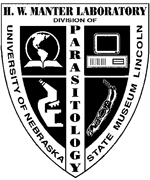Parasitology, Harold W. Manter Laboratory of

Harold W. Manter Laboratory of Parasitology: Library Materials
Document Type
Article
Date of this Version
11-2018
Citation
Frontiers in Cellular and Infection Microbiology (November 2018) 8: 405
doi: 10.3389/fcimb.2018.00405
https://www.frontiersin.org/articles/10.3389/fcimb.2018.00405/full
Editor: Brice Royureau
Reviewers: Mariane B. Melo and Oscar D. Salomón
Supplementary material: https://www.frontiersin.org/articles/10.3389/fcimb.2018.00405/full#supplementary-material
Abstract
Triatominae bugs are the vectors of Chagas disease, a major concern to public health especially in Latin America, where vector-borne Chagas disease has undergone resurgence due mainly to diminished triatomine control in many endemic municipalities. Although the majority of Triatominae species occurs in the Americas, species belonging to the genus Linshcosteus occur in India, and species belonging to the Triatoma rubrofasciata complex have been also identified in Africa, the Middle East, South-East Asia, and in the Western Pacific. Not all of Triatominae species have been found to be infected with Trypanosoma cruzi, but the possibility of establishing vector transmission to areas where Chagas disease was previously non-endemic has increased with global population mobility. Additionally, the worldwide distribution of triatomines is concerning, as they are able to enter in contact and harbor other pathogens, leading us to wonder if they would have competence and capacity to transmit them to humans during the bite or after successful blood feeding, spreading other infectious diseases. In this review, we searched the literature for infectious agents transmitted to humans by Triatominae. There are reports suggesting that triatomines may be competent vectors for pathogens such as Serratia marcescens, Bartonella, and Mycobacterium leprae, and that triatomine infection with other microrganisms may interfere with triatomine-T. cruzi interactions, altering their competence and possibly their capacity to transmit Chagas disease.
Barreto Vieira et al 2018 FCIM Supplementary material
Included in
Bacteriology Commons, Biodiversity Commons, Entomology Commons, Environmental Microbiology and Microbial Ecology Commons, Parasitic Diseases Commons, Parasitology Commons


Comments
Copyright 2018, the authors. Open acces
License: CC BY 4.0